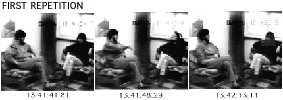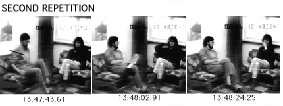|
DEPARTMENT OF ANTHROPOLOGY- HUMAN BEHAVIOR RESEARCH | human motion
|
The courtship dance:patterns of non-verbal synchronisation in opposite sex-encountersKarl Grammer, Kirsten B. Kruck and Magnus S. Magnusson (Journal of Non-Verbal Behavior 22(1) 1998, pp 3-29) Supplement to the publication Abstract This study was unable to demonstrate a relation between synchronization defined in terms of movement echo or position mirroring and subjective experience of pleasure and interest in opposite-sex encounters. Significant results could only be found for a phenomenon we describe as hierarchically patterned synchronization. These patterns were identified with the help of a newly developed search algorithm (THEME). If a female is interested in a male, highly complex patterns of behavior with a constant time structure emerge. The patterns are pair-specific and independent from behavioral content. This rhythmic structure of interactions is discussed in functional terms of human courtship. We found that synchronization exists on a completely different level than expected, with highly complex time structures, where inter-individual timing rapport between movements can be extended over considerable time spans. This method is complementary to other methods used to describe synchrony. Its drawbacks are basically the enormous coding effort. Hierarchical patterns of synchronization are present in all types of interactions and are independent of the sex of the interactants. Moreover, it seems to be independent from the content of behavior and it is highly idiosyncratic, because there is no correspondence in patterns between pairs. Each pair seems to put up its own rhythmic structure in an interaction. (See text and examples below ) |
|||||||||||||
| PATTERN 1 | |
 |
|
| PATTERN 2 | |
 |
|
| PATTERN 3 | |
 |
|
Behavioral
synchronisation in interactions is thought to be an expression of mutual
understanding of the interactants. In this work it was not possible to
demonstrate a relation between synchronisation defined in terms of movement
echo or position mirroring and subjective experience of pleasure and interest
in opposite sex-encounters. Significant results could only be found for
a phenomenon we describe as hierarchically patterned synchronisation.
These patterns were identified with the help of a newly developed search
algorithm. The material we analysed were 48 ten minutes interactions between
strangers of the opposite sex. The subjects were selected randomly from
visitor groups of the institute pretending that they would participate
in a rating experiment. After introducing the experiment the experimenter
left the couple alone in order to reply to an "urgent phone call".
The interaction then was videotaped through a one way screen (see Grammer,
1991). As controls 12 encounters between strangers of the same sex (6
female-female; 6 male-male) were used. The participants were of a mean
age of 18.5 years. If a female is interested in a male highly complex
patterns of behaviour with a constant time-structure emerge. The patterns
are pair-specific and independent from behavioural content. This rhythmic
structure of interactions is discussed in functional terms of human courtship.
The newly developed model model views behavioural organisation as a repetition
of a particular type of intra- and inter-individual, hierarchical/syntactical
behaviour patterns, each of which is characterised by similar time intervals
between its repetition branches. Patterns of this kind occur in a cyclical
fashion, although this is not one of their defining characteristics. The
pattern definition and the corresponding pattern detection method focuses
on the relationships between the occurrence times series of various behavioural
event types which constitute the data for the pattern detection software.
Each series of three pictures in one line shows a pattern which was isolated
by THEME (Click on the series will load down an P1:1.3; P2: 2.9; P3: 3.8
mb MPEG movie of the series; 10 Frames/sec, bw). The pattern consist of
three elements which are repeated three times. All three patterns are
identical: the male leans back, the female touches her hair, and then
her face. The temporal sequence organisation is identical for all three
patterns as shown in the graph below. The x-axis shows the time of occurence
in a 10-minute experiment, the y-axis the number of the movement. The
starting pattern occured as movement number 4, 9 and 11. Notice that there
are 4 movements between the first element (Male leans Back) and the second
element (Female Touches Hair), and one movement between the seond and
the last element (Female Touches Face) in the starting pattern. In the
first repetititon there are 3 respectively 25 movements seeded between
the pattern members. And the members of the second repetition are seperated
by 11 respectively 10 other movements. The second pattern starts at a
174.6 sec interval from the first pattern and the third patterns starts
in a 362.6 sec interval from the second. Internal time structure is coherent:
9.4 -> 4.1 sec difference in the first pattern (second pattern 6.0
->31.6, third pattern 18.2 -> 21.8).

|
UNIVERSITY OF VIENNA all rights reserved karl.grammer@univie.ac.at |
|